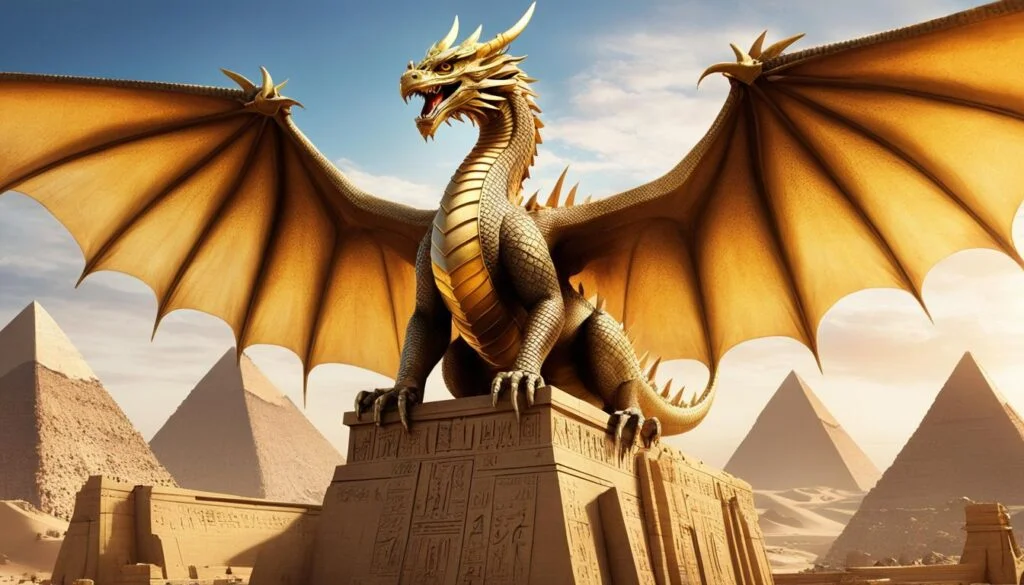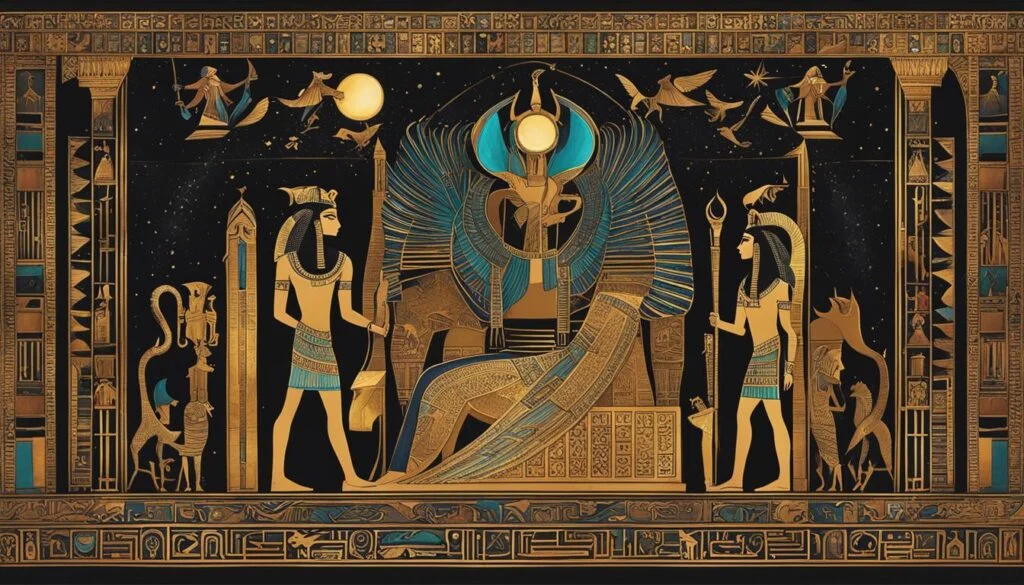In Egyptian mythology, there are several references to dragon-like creatures, also known as serpents. These mythical beings play significant roles in the ancient Egyptian culture and beliefs. Let’s explore the various dragons and serpent tales in Egyptian mythology to determine whether they are fact or fiction.
Key Takeaways:
- Dragons, or serpent-like creatures, are prevalent in Egyptian mythology.
- These mythical beings have significant cultural and symbolic meanings.
- The existence and origins of dragons in Egyptian mythology are subject to debate.
- Dragon legends may be influenced by real fossils or instinctive fears.
- Regardless of their origins, dragons hold immense cultural significance for the ancient Egyptians.
Mehen – The Coiled Serpent Protector
Mehen is a serpent known for its coiled form, believed to protect Ra in his nightly journeys on the Boat of the Sun. The earliest references to Mehen can be found in the Coffin Texts, a collection of funerary spells.
It is also interesting to note that Mehen is the name of a board game played in ancient Egypt, depicting a coiled snake. This connection between the serpent and the game adds to the intrigue surrounding Mehen and its significance in Egyptian mythology.
- Mehen safeguards Ra during his nightly travels
- Referenced in the Coffin Texts
- Connection between the snake and a board game
Nehebkau – The Primordial Serpent

Nehebkau is a fascinating character in Egyptian mythology, portrayed as a primordial serpent. With its depiction of arms, legs, and sometimes even wings, Nehebkau stands out among the dragon figures in Egyptian folklore. This serpent held a significant role in the underworld, serving as one of the forty-two assessors of Ma’at – the deities responsible for judging the souls seeking entrance to the afterlife.
Nehebkau’s story is shrouded in mystical tales, including the ability to swallow cobras and even breathe fire. As the serpent evolves throughout Egyptian mythology, it eventually transforms into a benevolent deity. This transformation showcases Nehebkau’s prowess and unique characteristics.
Nehebkau’s influence in Egyptian mythology and culture makes it an intriguing figure to explore. With its association with the underworld and its role in soul judgment, Nehebkau adds depth and complexity to the rich tapestry of Egyptian dragon mythology.
Nehebkau’s Key Attributes:
- Primordial serpent
- Depicted with arms, legs, and wings
- Associated with the underworld
- One of the forty-two assessors of Ma’at
- Tales of swallowing cobras and fire-breathing
- Transforms into a benevolent deity
Nehebkau’s unique characteristics and role in Egyptian mythology embody the allure and enigma surrounding the dragon figures in ancient Egypt. As we continue to explore the world of Egyptian dragon mythology, we’ll delve into more captivating stories and legends that have captivated generations.
Ammut – The Eater of Hearts
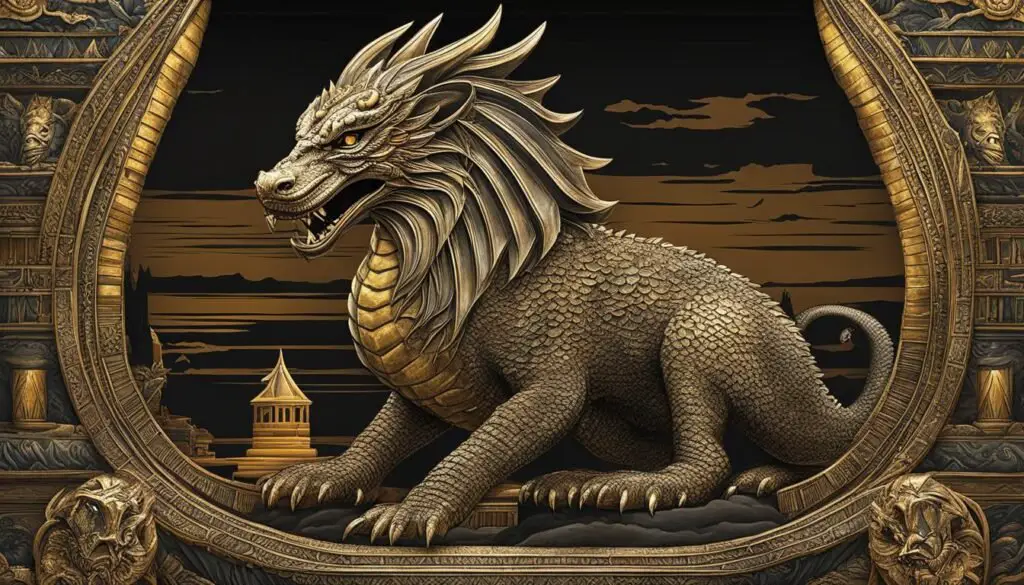
Ammut, also known as Ammit, is a fearsome creature from ancient Egyptian mythology. Known as “The Eater of Hearts,” Ammut played a significant role in the Dead Court. In this court, the hearts of the deceased were weighed against the feather of truth to determine their fate in the afterlife.
If a person’s heart was deemed unworthy, Ammut would consume it, leading to eternal restlessness. The idea of one’s heart being devoured by this dragon-like creature carried great weight and symbolism in Egyptian culture. The fear of facing Ammut’s judgment served as a powerful deterrent to ensure moral conduct during one’s lifetime.
Ammut’s appearance further adds to the mythical and intimidating nature of this creature. With the head of a crocodile, the body of a leopard, and the hindquarters of a hippopotamus, Ammut embodies the ferocity and relentlessness that one would associate with a dragon.
In Egyptian mythology, Ammut represents the consequences of a life lived without righteousness and serves as a reminder to strive for moral integrity and balance. The tales and legends surrounding Ammut continue to captivate audiences, illustrating the lasting impact of dragons in ancient Egyptian culture.
Denwen – The Fiery One

Denwen, also known as the Fiery One, is a dragon-like creature associated with fire. In Egyptian mythology, Denwen was believed to possess powerful flames that had the potential to bring about an extinction event for the entire Egyptian pantheon. This fearsome dragon represented absolute evil and destruction.
However, the Pharaoh in ancient Egyptian legends was able to overcome Denwen, showcasing their divine right to rule and protecting the land from imminent catastrophe. This epic battle between the Pharaoh and Denwen symbolizes the eternal struggle between good and evil.
The story of Denwen highlights the formidable and destructive power often associated with dragons in Egyptian mythology. It exemplifies the significance of mythical creatures in ancient Egyptian culture and the enduring impact they have had on Egyptian folklore and storytelling.
The Origin of Dragons in Mythology
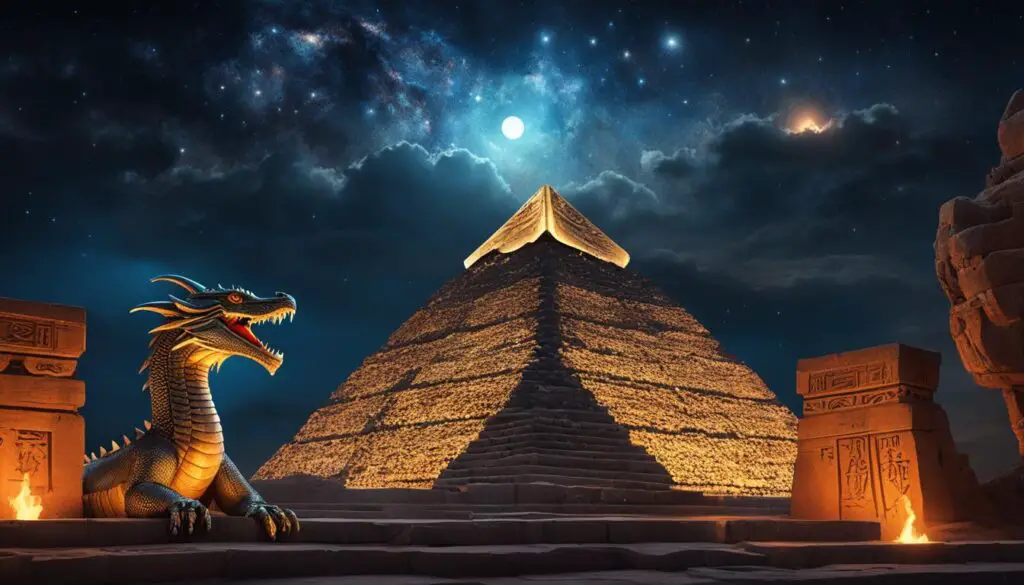
The origin of dragons in Egyptian mythology and folklore is still a subject of debate. While some believe that these legends may have been inspired by real dinosaur fossils or giant prehistoric creatures, others argue that dragons emerged from a convergence of human instinctive reactions to snakes and other dangerous animals. Regardless of their origins, dragons have become an integral part of Egyptian culture and serve as symbols of power, protection, and the eternal struggle between order and chaos.
In ancient times, the Egyptians revered serpents and often associated them with divine entities and powerful deities. These associations laid the foundation for the development of dragon-like creatures in Egyptian tales and myths. The imagery of serpents as dragons symbolizes their immense strength, wisdom, and connection to both the earthly and spiritual realms.
Egyptian serpent tales depict these creatures as majestic and awe-inspiring beings, capable of both benevolence and destruction. They often serve as guardians of sacred sites, protectors of the pharaohs, and representatives of cosmic forces. The symbolism of dragons in Egyptian mythology extends beyond their physical form, representing the eternal struggle between order (represented by the pharaoh and the divine) and chaos (represented by the forces that threaten to disrupt the natural order).
To further understand the symbolic significance of dragons in Egyptian culture, it is important to explore the ancient Egyptian dragon legends and their portrayal in various myths and stories. These tales offer valuable insights into the role of dragons as catalysts for change, rebirth, and the preservation of cosmic balance.
Ancient Egyptian Dragon Legends
- The legend of Mehen: Mehen, the coiled serpent, was believed to protect Ra, the sun god, in his nightly journeys across the sky. Mehen’s form and association with the powerful sun god make it a popular subject in ancient Egyptian art and iconography.
- The tale of Nehebkau: Nehebkau, the primordial serpent with arms and legs, played a crucial role as one of the forty-two assessors of Ma’at. Its story involves swallowing cobras, fire-breathing abilities, and transformation into a benevolent deity, showcasing the complexity and transformative nature of these legendary creatures.
- The myth of Ammut: Ammut, with its crocodile head, leopard body, and hippopotamus hindquarters, served as the fearsome Eater of Hearts in the Dead Court. Its appearance and role in the afterlife judgment highlight the consequences of imbalance and the importance of leading a righteous life.
- The story of Denwen: Denwen, also known as the Fiery One, represented absolute evil in Egyptian mythology. This dragon-like creature possessed powerful flames capable of causing widespread devastation. Its defeat by the pharaoh symbolized the triumph of order over chaos.
The imagery and symbolism associated with these dragon legends demonstrate the significance of dragons in ancient Egyptian culture. The stories and beliefs surrounding these creatures reflect the human fascination with the unknown, the awe-inspiring forces of nature, and the eternal struggle between good and evil.
As we delve deeper into the world of Egyptian serpent tales, we uncover a rich tapestry of mythology, symbolism, and cultural significance. The dragons of ancient Egypt continue to captivate our imagination and remind us of the timeless themes that resonate across cultures and civilizations.
Scientific Interpretation of Dragons
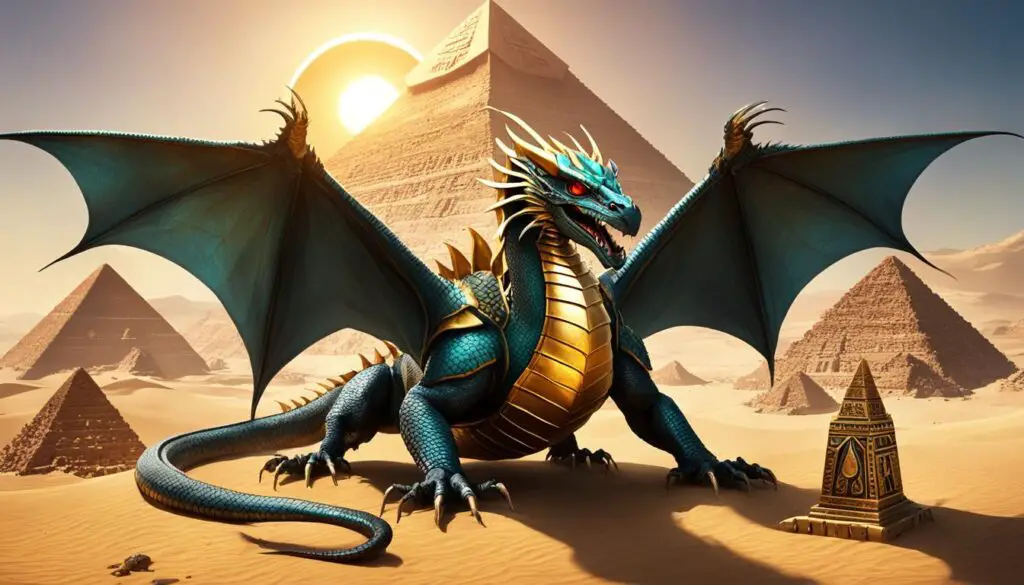
Scholars and scientists have delved into the intriguing world of dragons, aiming to unravel the truth behind these mythical creatures from a scientific perspective. One prevailing theory suggests that dragon legends, including those in ancient Egyptian mythology, may have been influenced by the discovery of fossils.
Ancient reptiles and prehistoric mammals found as fossils could have played a role in the creation and perpetuation of dragon myths. As early cultures encountered these fossilized remains, misinterpretations could have given rise to tales of mighty dragons and serpent-like creatures.
The allure of dragon legends, such as the famed Egyptian serpent tales, lies in their ability to captivate and transport us to a realm where fantastical creatures reign. Scientific exploration offers fascinating insights into the origins of these myths, shedding light on the cultural significance they hold.
Cultural Significance of Dragons
Conclusion
Dragons and serpent-like creatures have long held a significant place in ancient Egyptian culture and mythology. Whether their existence was inspired by real fossils, ancient reptiles, or purely the product of imaginative storytelling, the legends and tales surrounding these mythical creatures continue to captivate generations.
These dragon stories in Egyptian mythology reflect the cultural beliefs, fears, and aspirations of ancient Egyptians. The presence of dragons in religious rituals, their symbolism in divine judgments, and their association with powerful deities highlight their enduring appeal and importance.
From Mehen, the coiled serpent protector, to Nehebkau, the primordial serpent, each dragon figure in Egyptian mythology carries its unique characteristics and represents different aspects of the cosmic order. The fiery Denwen, symbolizing ultimate evil, and the fearsome Ammut, the eater of hearts, add intrigue and depth to the dragon lore.
While the true origins of dragons in Egyptian mythology may remain a subject of debate, their cultural significance cannot be denied. Dragons serve as reminders of the delicate balance between order and chaos, the power of protection, and the eternal struggle between light and darkness. They continue to enchant and intrigue, leaving a lasting impact on Egyptian culture and imagination.
FAQ
Are there dragons in Egyptian mythology?
Yes, Egyptian mythology includes references to dragon-like creatures, also known as serpents.
What is Mehen in Egyptian mythology?
Mehen is a serpent known for its coiled form, believed to protect Ra in his nightly journeys on the Boat of the Sun.
Who is Nehebkau in Egyptian mythology?
Nehebkau is a primordial serpent associated with the underworld and has a significant role as one of the forty-two assessors of Ma’at.
What is Ammut in Egyptian mythology?
Ammut is a fearsome creature known as the Eater of Hearts and plays a role in the Dead Court, where the hearts of the deceased are weighed against the feather of truth.
What is Denwen in Egyptian mythology?
Denwen, also known as the Fiery One, is a dragon-like creature associated with fire and represents absolute evil in Egyptian mythology.
What is the origin of dragons in Egyptian mythology?
The origin of dragons in Egyptian mythology is still debated, with theories suggesting inspiration from real dinosaur fossils or a convergence of human reactions to dangerous animals like snakes.
How can dragons in Egyptian mythology be interpreted scientifically?
Some theories suggest that dragon legends may have been influenced by the misinterpretation of ancient reptile and prehistoric mammal fossils.
What is the cultural significance of dragons in Egyptian mythology?
Dragons represent power, protection, and the balance between order and chaos in Egyptian culture.
What is the conclusion regarding dragons in Egyptian mythology?
Dragons and serpent-like creatures in Egyptian mythology are a fascinating aspect of ancient Egyptian culture, holding significant cultural and symbolic importance.


